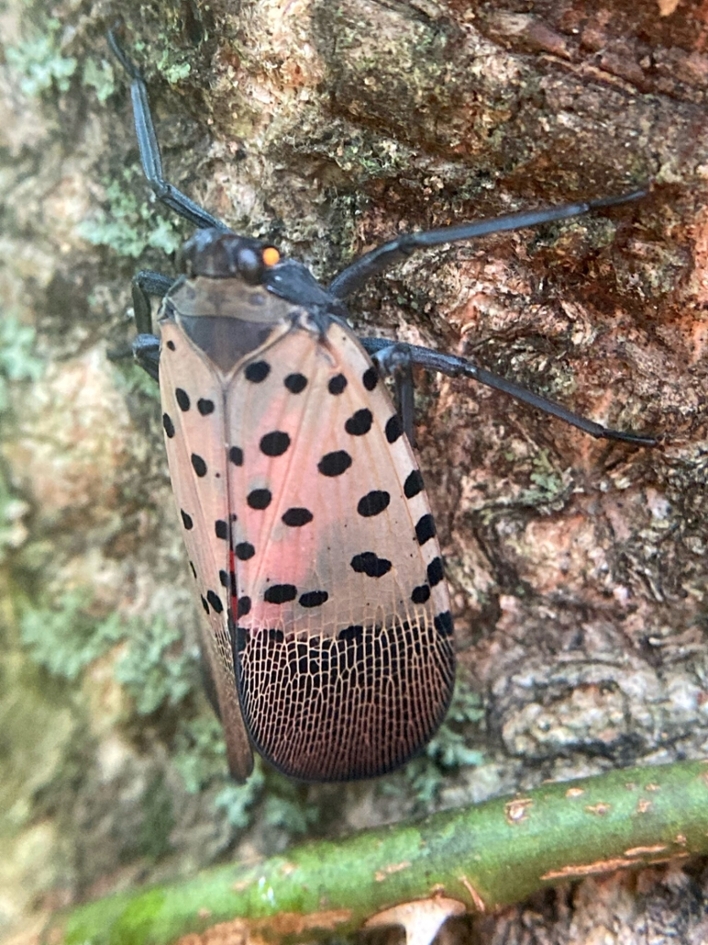New Invasive Insect Pest Found in Northern Indiana
Above: A group of the late stage 4th instar nymphs of spotted lanternfly. Photo taken by Vince Burkle (DNR DEPP).
Last August, I wrote about an invasive insect pest new to Indiana that was found in far southeastern Indiana, implying that it may take some time to reach northern Indiana. This insect apparently found other means of transportation to reach our region.
Cliff Sadof, in the Purdue Landscape Report, recently reported that the spotted lanternfly (SLF) was found in late July in Huntington, Indiana. “This federally regulated invasive species is a serious new pest that harms plants by slowing their growth and reducing fruit production, especially in vineyards and orchards,” he said. “Finding this pest this far north of last year’s find along the Ohio River in Vevay, IN makes it possible for SLF to be anywhere in Indiana.”
“Right now, the Indiana DNR (Department of Natural Resources) is asking for all citizens to search for and report spotted lanternfly,” he said. “The bright color of late-stage immatures and adults are easily recognized at this time of the year.” Report by calling 866-NO EXOTIC (866-663-9684) or send an email with a photo to DEPP@dnr.IN.gov.
The spotted lanternfly is a planthopper native to Asia. It was first discovered in Pennsylvania in 2014, and Penn State Extension has led research efforts on the pest in recent years in cooperation with the Pennsylvania Department of Agriculture.
“If not contained, spotted lanternfly potentially could drain Pennsylvania’s economy of at least $324 million annually, according to a study carried out by economists at Penn State,” stated Penn State Extension’s website on SLF. It demonstrates why we are seriously concerned with the discovery of this pest in Indiana, the farthest west in the United States that it has been confirmed to date.
“Adult spotted lanternfly has two sets of wings, and the underwing has a very distinct red color with spots on the outer wings,” Sadof said. “The fourth instar of the insect is bright red with black and white markings.” Instars are immature and smaller forms of the insect, also called nymphs. As it feeds and grows, it molts (sheds an exoskeleton) to advance to the next and larger instar stage. The first through third instars of SLF are only black with white spots. The fourth instar exhibits a striking red color with black markings and white spots. It is the last stage before becoming a mature adult with fully developed black-spotted wings.
What makes this insect particularly difficult to contain is that it excels as a hitchhiker, and it feeds on a wide variety of plants. They can be spread by vehicle transport, including recreational vehicles, trucks, and freight trains. They can also move on shipped materials.
Although it has not been determined how the insect found its way to Huntington, the find was near a railroad track. Officials are determining how large the infestation is and where it could have come from, as well as how to limit the spread and eradicate the population.
“Spotted lanternfly prefers to feed on tree of heaven (Ailanthus altissima), but it has been found on more than 103 species of plants including walnut, oak, maple, and various fruit trees,” Sadof said. “This insect is often found on grapevines in vineyards.”
“Adult insects can greatly weaken plants when feeding on them with their piercing-sucking mouthparts,” he said. “Plants weakened by SLF may be unable to survive the winter months.” He added that heavily infested trees can become coated with the sticky liquid excrement of SLF called “honeydew” which will attract stinging insects. Over time, the honeydew becomes infested with an unsightly black sooty mold that slows plant growth and makes a mess of cars and picnic areas.
Some may confuse SLF with annual cicadas, tiger moths, milkweed bugs, boxelder bugs, or other insects. Your county Purdue Extension office should be able to help you sort out look-alikes from the real thing.
Find information from Indiana DNR at: https://www.in.gov/dnr/entomology/pests-of-concern/spotted-lanternfly/. Find Sadof’s recent article at: https://www.purduelandscapereport.org/article/spotted-lanternfly-now-in-northern-and-southern-indiana/. Additionally, find USDA’s Pest Alert factsheet on SLF at: https://www.aphis.usda.gov/publications/plant_health/alert-spotted-lanternfly.pdf.

Above photo: Spotted lanternfly adult. Photo taken by Ren Hall (DNR DEPP).
